Measuring pH in a food-safe environment
Food processing covers a wide range of activities all of which require both food safety and quality standards to be met to ensure that consumers receive high quality products. One of the more vital parameters that plays a part in this is pH since it governs both physical and chemical reactions during food production as well as inhibiting the growth of pathogens.
Ian Webster, Hygienic Processing Segment Manager at Bürkert UK, looks at the importance of measuring pH and the most efficient methods of achieving accurate pH control.
Ever since we discovered cheese and alcohol, man has been controlling the acidity of food in order to create different products. With an extraordinarily detailed understanding of how pH can affect the look, taste and quality of a food product, we have now introduced precise pH control as part of general food processing and safety programmes covered by national regulatory bodies.
Every micro-organism has a minimum, optimum and maximum pH for growth. Useful yeasts and moulds, for example can grow at low pH, but 4.6 and below is generally considered the level that will prevent the growth and toxin production of harmful pathogens. However, going too far can have detrimental effects of its own. It is therefore necessary to have suitable testing equipment that can measure pH with sufficient accuracy in order to ensure product quality and compliance with food safety regulations.
Monitoring of pH is also very important in the food production process especially in dairy products. Milk is tested for impurities and signs of infection both upon collection as well as at the point of delivery, while beer and wine producers rely on precise pH readings to determine the taste and quality of the final product. Finally, when a particular process is finished, an automated cleaning procedure can be used to prepare the production system for the next batch; hence, ensuring correct pH levels are maintained is also crucial in the hygiene management system.
Accuracy
Selecting the most appropriate pH meter requires three main points to be considered, the first of which is resolution and accuracy. At the cheaper end of the market, pH meters will typically have a resolution of 0.1 pH units which will be sufficient for some data recording functions.
However, some of the least expensive meters may have an accuracy of plus or minus 0.2 units. In other words, if the meter reads 4.5, the actual pH of the product could be anywhere from 4.3 to 4.7. This might present a problem if the pH of your product were to exceed the safe limit of 4.6 for example. This can have significant consequences for food producers as they are required to either re-process any batches that fail to meet the criteria or destroy them.
Commercial pH sensors have a range of accuracies to account for different applications but 0.01 units would be expected in continuous food processing systems, where the sensors can also be set-up to trigger warning signals that allow corrections to be made before the process is out of specification.
Calibration
Accuracy is also dependent on correct calibration and temperature compensation. Calibration is completed using buffer solutions of precisely known pH values whilst also measuring the temperature. Since the pH of the solution is a function of its temperature, as the temperature changes, so does the pH, despite the concentration of acid or base remaining the same. [1]
It is therefore also important to ensure that measured pH values are compensated to allow for the difference between the measured temperature and the reference temperature, which is normally 25°C. In this way various pH readings can be directly compared without being affected by the temperature of the process.
Electrodes
Glass diaphragm electrodes use a reference electrode, suspended in a buffer solution of pH7 – that is compared to the measuring electrode and as such this design is used for a wide range of applications. For more robust applications single element electrodes made from enamel-coated steel or a polymer that use pH sensitive coatings are also available.
Bürkert uses a modular system that allows process engineers to build the most suitable pH sensing system, depending on the application. A variety of probes designed to operate in varying conditions and media can be combined with PT1000 temperature sensors and connected to a transmitter / controller such as the Type 8619 multiCELL. Combined with a choice of fittings and sealing materials as well as EHEDG certification, the product range can be specified to suit most applications within the food industry.
In general glass pH electrodes are not suitable for food applications due to the risk of broken glass fragments contaminating the process. Furthermore, many designs of pH electrode need to be removed from the process stream before the CIP process can be completed which requires expensive retraction systems to be employed, creating extra work and inconvenience for the end user.
One solution could be the Type 8201 pH measuring system, which employs a hygienic, robust and glass-free design that can withstand high temperatures and can be sterilised in situ. In addition, the smooth enamel external surface of the probe inhibits the process medium from sticking to it and is very easy to clean.
By using industry standard signals, these pH sensors can either be integrated into an existing process control system or used in conjunction with other control components. This can provide localised feedback for a closed loop control system, for example to ensure the correct dosing of a product with pH sensors both before and after the process.
Material specification of the sensor body and the sealing components can also play an important role in the performance of the pH sensor within the wider process control environment. This is particularly true when dealing with extremes of pH which can be highly reactive and corrosive. Sensor manufacturers with specialist knowledge in this area should be available to support customers to ensure that both process and hygiene control are properly managed.
The wide variety of manufacturing processes in the food industry that require pH levels to be monitored and controlled means that sensors need to selected accordingly to suit each application. Media purity, temperature and pressure all need to be accounted for as well as portability and calibration frequency. All of these areas should be carefully considered along with expert technical advice from manufacturers such as Bürkert.































